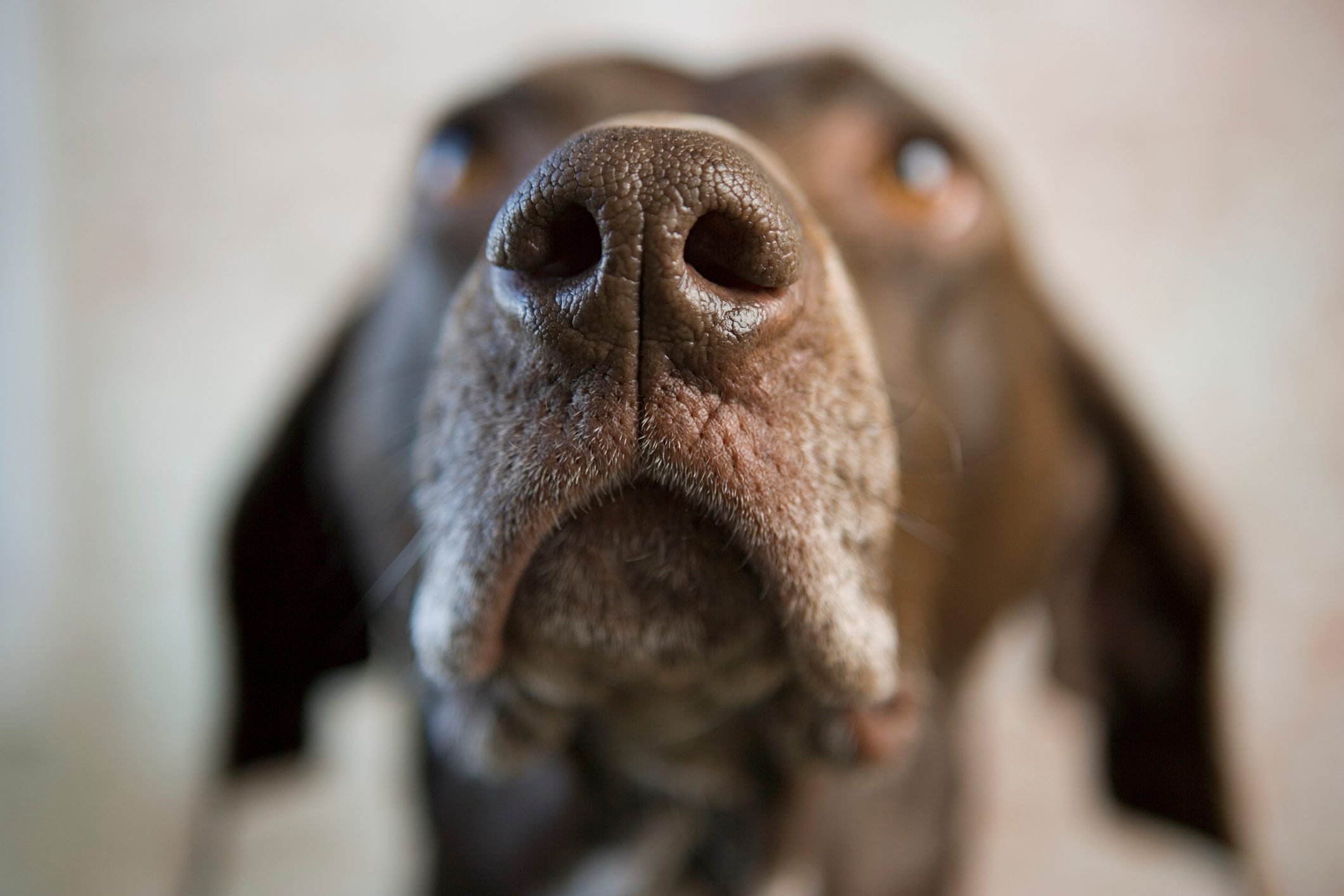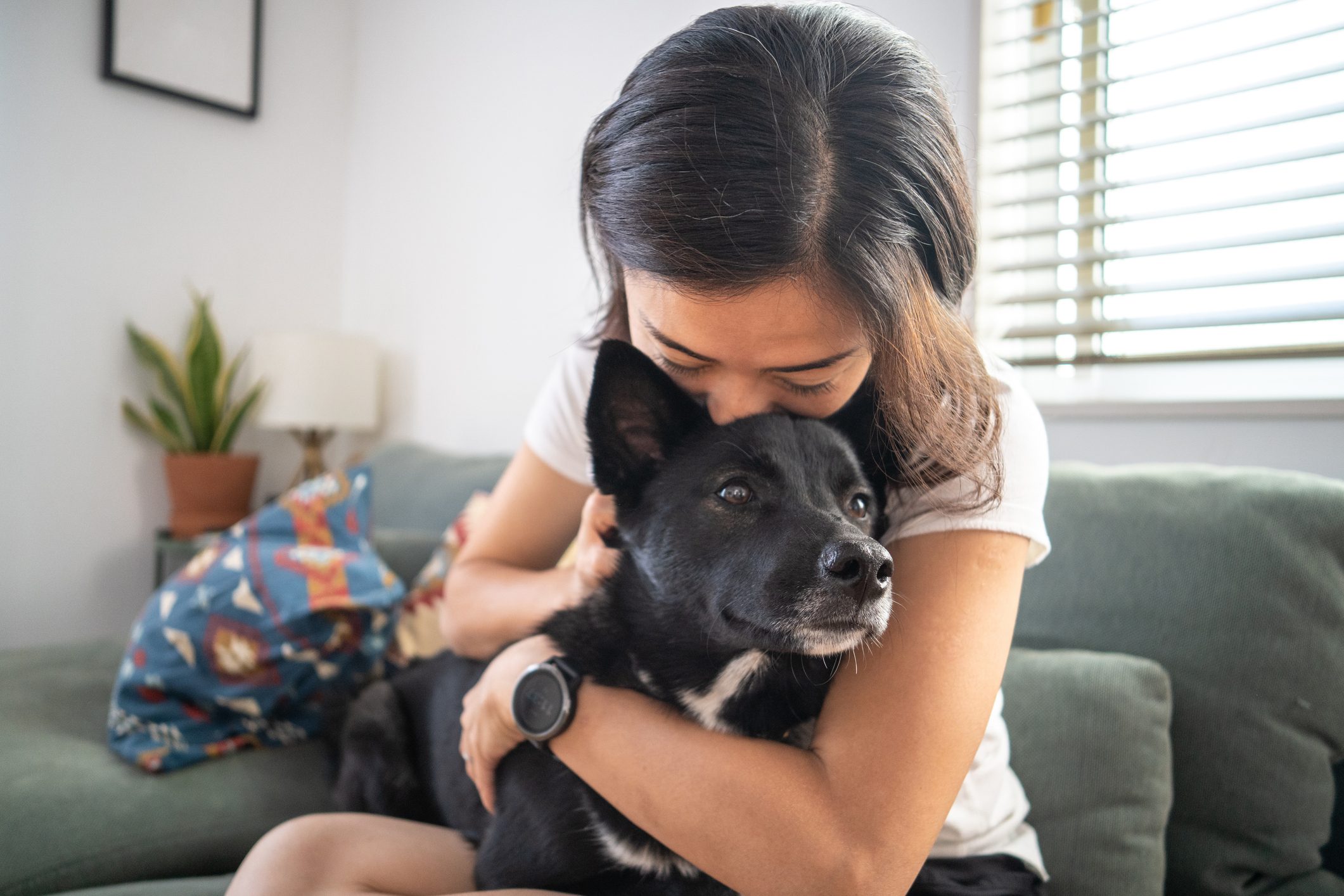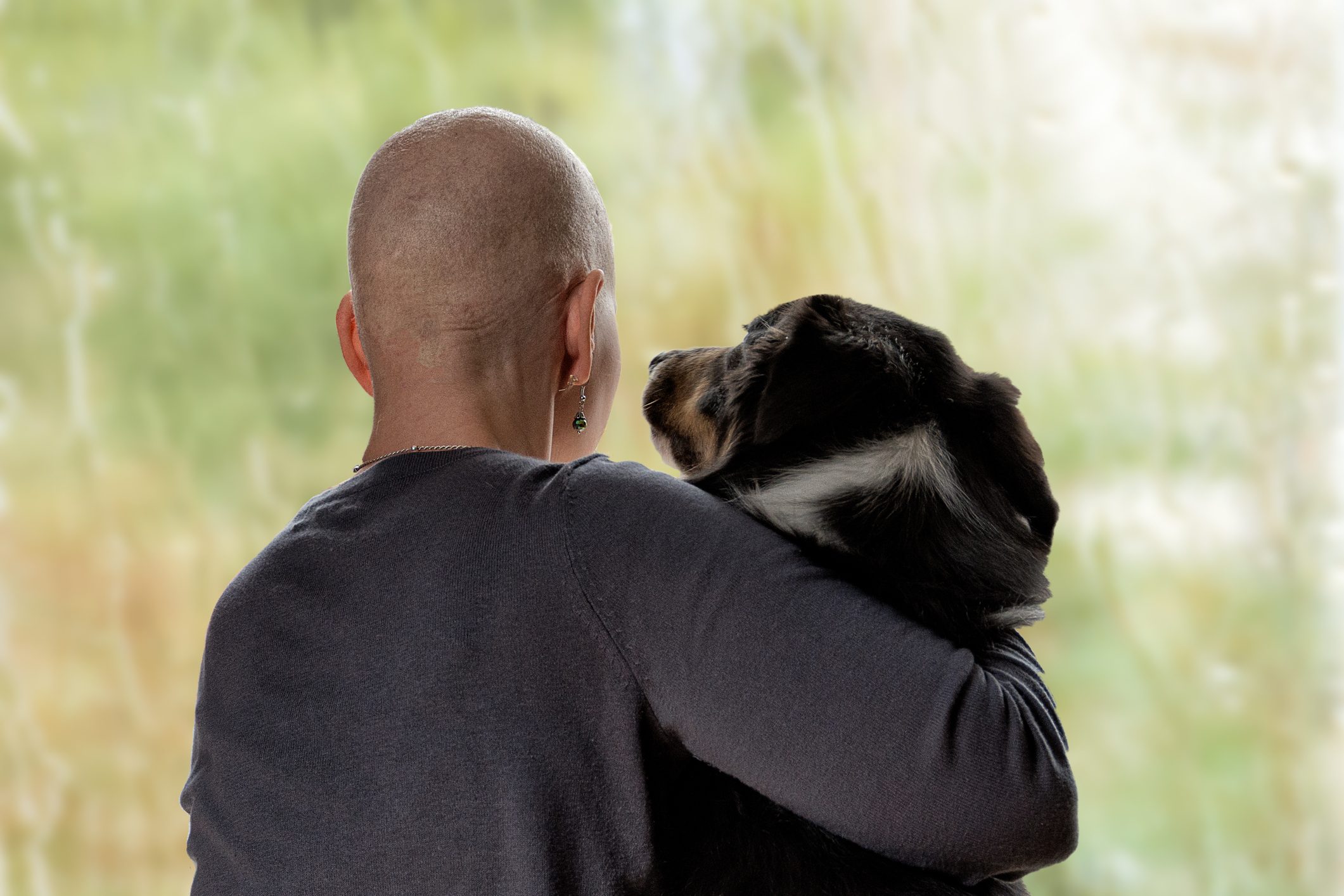With their powerful noses and passion for helping people, detection dogs remind us why dogs truly are man's best friend

11 Things Dogs Can Smell That Humans Can’t


Emotions
A recent study found that not only can dogs detect our stress, but, in turn, our stress stresses out our dogs. Fortunately, service dog organizations can train dogs to channel those detection skills as psychiatric service dogs who can alert handlers to the onset of anger, anxiety and panic attacks.
Dr. Cattet’s nonprofit Medical Mutts Service Dogs rescues dogs from shelters to train them for the task. All dogs have the ability to detect odors (even flat-faced dogs like pugs), like the stress hormone cortisol, so they are selected for other characteristics, like being food motivated, since the organization only uses positive training methods and rewards success with treats.
“We do not test dogs for their ability to smell when we select them from shelters,” she says. “We don’t need to do that.”
The team trains dogs for clients like veterans with PTSD by collecting skin swabs and breath samples while the handler is in a calm state, and when they are agitated. The dog learns to distinguish between the odors and help at the onset of a panic attack by nudging their handler with their snout, applying calming pressure, leading them out of a crowd and back to the car, pressing a button to call for help or even waking the person during a nightmare or night terrors. Once aware of their emotional state, a handler can take a deep breath, leave a situation or take medication if needed.

Diseases
Dr. Otto’s team at the Penn Vet Working Dog Center studies the most effective practices for raising and training a variety of working dogs, which they’ve found includes positive training methods and letting the dogs choose their job. Some prefer work as disease detection dogs—including infectious diseases like Covid, chronic wasting disease in deer and others.
Her dogs can detect pancreatic and ovarian cancers, and are showing impressive results in a new project to detect hemangiosarcoma, an aggressive cancer, in dogs.
“I talk about medical detection dogs as being a little bit like your CPA who can look at a spreadsheet and find the one error out of thousands of entries,” she says.

Health conditions
One of the most intimate ways service dog organizations have harnessed the incredible dog sense of smell is to assist people with health conditions. Dr. Cattet and her team at Medical Mutts Service Dogs train detection dogs to alert to a variety of medical-related scents, including the onset of seizures and migraines, blood sugar fluctuations in people with diabetes and hypoglycemia, cardiac issues, syncope (fainting) and postural orthostatic tachycardia syndrome (aka POTS, which involves increased heart rate, dizziness and fatigue when rising from a prone position).
By alerting handlers to a physical change, they can respond appropriately, such as taking insulin or medicine, depending on the situation. Medical Mutts trains shelter dogs as well as pets of clients. One famous example is Lilah, a pet dog of Charlie Kimball, the first IndyCar driver with diabetes to ever qualify for and finish the Indianapolis 500. Lilah learned to alert Kimball to blood sugar drops by nudging his leg with her nose—then barking and finding his wife if he didn’t respond.
That dogs can not only detect a scent but problem solve and respond accordingly is a hallmark of the species, according to Dr. Cattet. For instance, if a person experiences a seizure, the scent doesn’t go away—it’s all over their clothes and body, stronger even than the sample the dog trained on. So seizure detection dogs have to decide when to alert and when not to.
“The truth is there’s a brain behind that nose,” she says. “They’re not just a detector.”
While there’s scientific evidence of a detectable scent related to diabetes, seizures, and psychiatric conditions, researchers are still working to pinpoint exactly what dogs are alerting on in many other cases, according to Dr. Cattet. In the meantime, dogs can train on volitile organic compounds collected from an individual to detect changes in their body.
“There’s a change in our smell when something’s going on with our bodies and the dogs are picking up on that,” she says. “It’s a fascinating field because it’s so new and there’s so much to discover.”

Electronics
A black Labrador retriever named Bear found the electronic evidence—a thumb drive—that helped the FBI put former Subway pitchman Jared Fogle behind bars for child pornography and sex acts with minors. Since the successful 2015 raid, Bear’s handler, Todd Jordan of Jordan Detection K-9 in Indianapolis, has trained over 200 electronic storage detection (ESD) K-9s for law enforcement officials.
There’s a chemical compound (triphenylphosphine oxide) present in all electronic devices to keep them from overheating. Humans can’t smell it, but dogs can, so trainers like Jordan teach ESD K-9s to detect it to find hidden flash drives, cell phones, memory cards, cameras and room keys—any electronic evidence of crimes against children, or any crime, for that matter.

Environmental threats
Because dogs see the world through scent, they are typically faster and more efficient than humans at finding invasive species and the scat of endangered animals, according to Alice Whitelaw, co-founder and director of programs for Working Dogs for Conservation, a nonprofit based in Missoula, Montana, that has trained detection dogs to work in over 36 countries and 45 U.S. states.
The nonprofit rescues dogs from shelters who have a strong desire to play with a toy with a human—which is their reward for a successful find.
“When the dogs are out there, they only have one thing on their mind,” she says. “They are not thinking about anything except the game.”
Dogs help conservationists by sniffing out invasive plant species like dyer’s woad in Montana, or beetles like the emerald ash borer in Minnesota, checking boats for rats to prevent them from getting onto sensitive islands populated by penguins, such as a post-eradication survey project on Wake Island in Micronesia, or finding black footed ferrets in Arizona.
They can save time and money by differentiating between the scat of the endangered kit fox and a coyote, which look similar and can be found in the same areas. Dogs from the organization found grizzly bear scat that halted a proposed real estate development in the midst of their habitat in the Centennial Mountains of Montana and Idaho.
The nonprofit has trained conservation dogs to detect over 100 scent targets in its 25-year history; a Labrador retriever mix named Wicket detected 31 different scents over the course of her career.
Currently, the organization is training dogs to detect sea otter scat found on land while aboard boats, building off work by University of Washington environmental biologist Dr. Samuel Wasser, whose program Conservation Canines has trained dogs to detect whale scat from boats. Her current dog, a German shepherd named Rue, is working to protect endangered lizards and endangered kit fox in California and learning to detect diseases that affect bison and bighorn sheep.
“When you start working with a dog in the field and you are problem solving together, nothing beats it,” Whitelaw says. “It gives me goosebumps.”

Ignitable liquids
Dogs can detect a single drop of ignitable liquids like gasoline and diesel, so for more than 30 years, many detectives have partnered with K-9s to detect arson and locate arsonists. Arson dogs will search burned buildings, charred cars and scorched terrain for evidence of arson so quickly and effectively that it limits the amount of time first responders and police officers have to spend in a potentially dangerous and toxic environment. Handlers are adept at reading a dog’s body language to recognize an alert, such as freezing or raising their snout under an accelerant.
Arson dogs also circulate in the crowds that gather near the scene of a fire to see if the arsonist stayed behind to watch their handiwork. I once interviewed a detective who chuckled as he told me that he’d seen his arson dog, a friendly Labrador retriever, alerting on a suspect’s shoes while the oblivious man kept petting the dog and saying, “Look—the dog likes me!”
The National Fire Dog Monument in Washington, D.C. features a bronze statue of a firefighter and an arson dog gazing at each other. Titled “From Ashes to Answers” and unveiled in 2013, the 7-foot-tall monument sits kitty-corner from the National Building Museum.

Poaching contraband
Working Dogs for Conservation also trains dogs to catch poachers by sniffing out wildlife contraband like rhino horn, ivory, bushmeat and pangolin scales. The dogs work primarily in Africa to detect the contraband as well as guns and ammunition used by poachers. In Central Asia and the United States, dogs can sniff parcels and shipping containers to ensure the contraband doesn’t reach buyers.
While the work is serious and curbs illegal practices, the canines just use their awesome dog sense of smell to get to play with their favorite toy with their favorite person, according to Whitelaw.
“If they’re not having fun, they’re not an effective co-worker,” she says. “It’s all based in fun.”

People
Search-and-rescue (SAR) dogs give us another endearing reason why dogs are dubbed “man’s best friend.” These intrepid dogs head into natural and manmade disasters to search for people buried alive. Dr. Otto was so moved watching dogs searching for survivors in the rubble of the World Trade Center after 9/11 that she created the Penn Vet Working Dog Center.
SAR dogs can be dropped by helicopter onto the side of a mountain with their handlers to hunt for missing hikers, or head into heavily wooded areas to track a lost child or a senior with dementia. Avalanche dogs can dig through deep snow to rescue a buried skier or snowboarder—an intriguing evolution from the SAR dogs who helped monks rescue stranded travelers in the Swiss Alps in the 17th century.
Search dogs can also find human remains to help bring closure to families of missing people. Keb, a yellow Lab featured in the book A Dog’s Devotion: True Adventures of a K9 Search and Rescue Team, found the jawbone of a woman who’d been missing for nine years.

Drugs
The powerful dog sense of smell is useful to law enforcement working to keep illicit drugs off the streets. In 2021, Romik, a K-9 with the West Tennessee Drug Task Force, searched a car and discovered over 11 pounds of heroin mixed with fentanyl—which agents said was enough to kill 2.5 million people.
Drug-sniffing dogs can identify a variety of narcotics and other illegal drugs, including cocaine, methamphetamine, marijuana, PCP, heroin, and fentanyl. They can search passengers and luggage at airports, vehicles at checkpoints, and homes while officers execute a search warrant.
Bruno, a Lab rescued from Ukraine and trained in Germany as a K-9 before partnering with Detective Harrison Williams of the Fort Myers Police Department in Florida, can detect a trace amount of narcotics on the handle of a car door. Since he works on a gang taskforce, often detecting drugs leads to officers discovering illegal firearms as well. Like many detection dogs, Bruno’s reward is playing with his favorite tug toy.
Dogs can also search addiction recovery centers for contraband, which can feel less threatening to residents than a human search.

Explosives
Many dogs raised and trained at the Penn Vet Working Dog Center choose to become explosives detection dogs, according to Dr. Otto. These dogs work with law enforcement to protect large gatherings of people from bombs.
Canine graduates have screened crowds at sporting events and other big public events. In fact, six graduates helped law enforcement with safety protocols in 2015 when Pope Francis visited Philadelphia, drawing over a million visitors.
“That was another proud moment,” she recalls.
Certified explosives detection dogs can detect over 20 different explosives odors to keep people safe. Since the early 1990s, the U.S. Bureau of Alcohol, Tobacco, Firearms and Explosives (ATF) has combated terrorism abroad by placing over 300 explosives detection canine teams in 13 countries.

Pests
A dog’s keen sense of smell can sniff out pests like bed bugs. Hotels, senior living facilities, and private homeowners will hire bed bug dogs to check to see if every last bed bug has been eradicated to avoid another infestation—or prevent one in the first place.
In 2023, I interviewed a bed bug dog handler in New Mexico who told me he cautions clients to avoid cooking bacon or leaving out tennis balls just before a search to avoid distracting his dog from the job at hand, which struck me as amusingly prudent. His dog can clear a hotel room in 30 seconds and doesn’t alert on dead bed bugs.
Detection dogs also protect a precious commodity: wine. Wineries can use detection dogs to find mealybugs and other pests in the vineyard instead of using pesticides. Since 2012, Chile-based cooperage TN Coopers has employed Labrador retrievers to sniff out the chemical compound TCA (2,4,6-Trichloroanisole), which can taint corks, wooden barrels, and packaging and ruin wine. Cheers to those dogs!
About the experts
|
Why trust us
At Reader’s Digest, we’re committed to producing high-quality content by writers with expertise and experience in their field in consultation with relevant, qualified experts. We rely on reputable primary sources, including government and professional organizations and academic institutions as well as our writers’ personal experiences where appropriate. For this piece, Jen Reeder tapped her experience as a longtime pet journalist, the former president of the Dog Writers Association of America and a dog owner. We verify all facts and data, back them with credible sourcing and revisit them over time to ensure they remain accurate and up to date. Read more about our team, our contributors and our editorial policies.
Sources:
- Cynthia M. Otto, DVM, Ph.D., DACVECC, DACVSMR, executive director of the Penn Vet Working Dog Center; phone interview, June 18, 2025
- Jennifer Cattet, Ph.D., executive director of Medical Mutts Service Dogs; phone interview, June 16, 2025
- Alice Whitelaw, co-founder and director of programs for the nonprofit Working Dogs for Conservation; phone interview, June 16, 2025
- Applied Animal Behaviour Science: Effects of learning an increasing number of odors on olfactory learning, memory and generalization in detection dogs
- Journal of Comparative Psychology: Performance of Pugs, German Shepherds, and Greyhounds (Canis lupus familiaris) on an odor-discrimination task
- ATF: Accelerant and Explosives Detection Canines



















